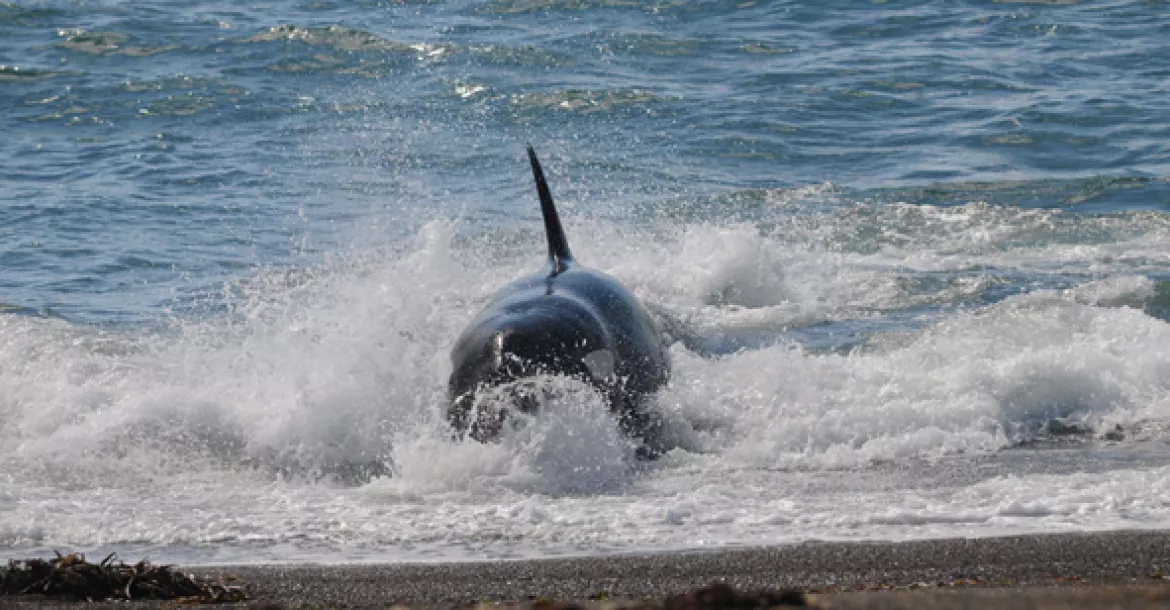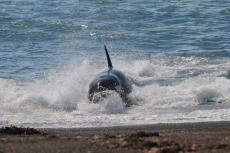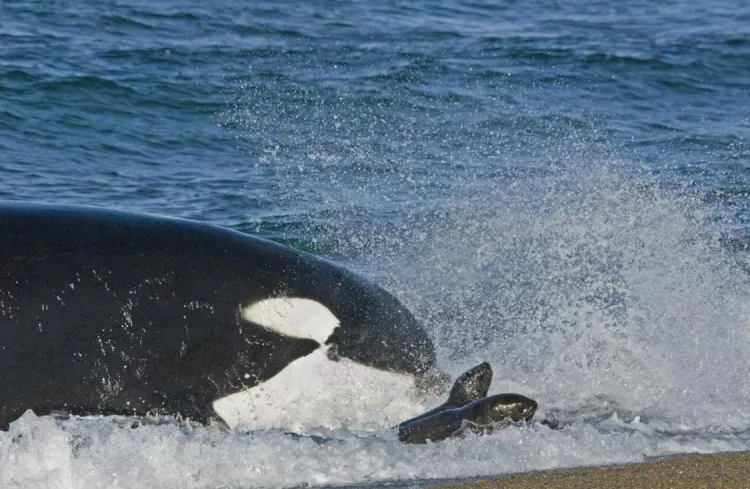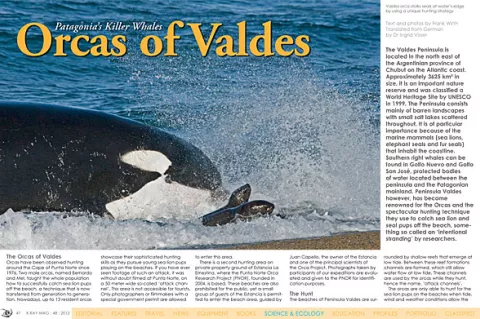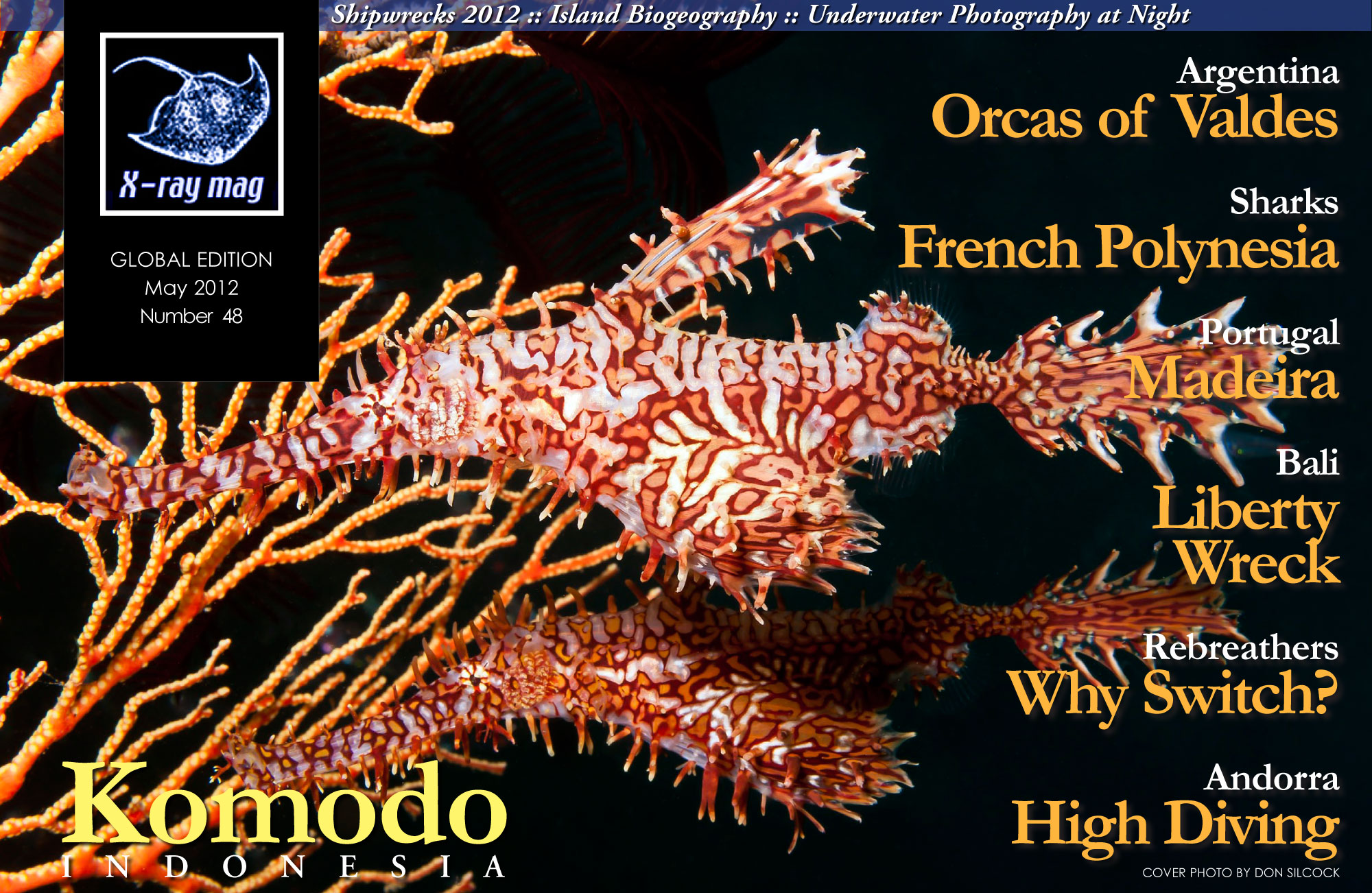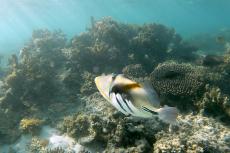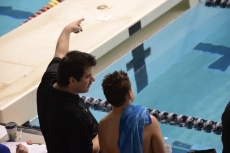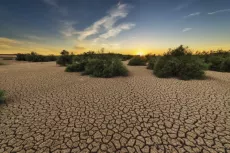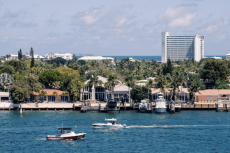The Valdes peninsula in Patagonia, has become renowned for the Orcas and the spectacular hunting technique they use to catch sea lion and seal pups off the beach, something so called an ‘intentional stranding’ by researchers.
Contributed by
The Orcas of Valdes
Orcas have been observed hunting around the Cape of Punta Norte since 1976. Two male orcas, named Bernardo and Mel, taught the whole population how to successfully catch sea lion pups off the beach, a technique that is now transferred from generation to generation. Nowadays, up to 13 resident orcas showcase their sophisticated hunting skills as they pursue young sea lion pups playing on the beaches. If you have ever seen footage of such an attack, it was without doubt filmed at Punta Norte, on a 50 meter wide so-called ‘attack channel’. This area is not accessible for tourists. Only photographers or filmmakers with a special government permit are allowed to enter this area.
There is a second hunting area on private property ground of Estancia La Ernestina, where the Punta Norte Orca Research Project (PNOR), founded in 2004, is based. These beaches are also prohibited for the public, yet a small group of guests of the Estancia is permitted to enter the beach area, guided by Juan Capello, the owner of the Estancia and one of the principal scientists of the Orca Project. Photographs taken by participants of our expeditions are evaluated and given to the PNOR for identification purposes.
The Hunt
The beaches of Peninsula Valdes are surrounded by shallow reefs that emerge at low tide. Between these reef formations channels are formed, which still allow water flow at low tide. These channels are used by the orcas while they hunt, hence the name, ‘attack channels’.
The orcas are only able to hunt for the sea lion pups on the beaches when tide, wind and weather conditions allow the animals to get close to the shore. Typically, the orca can start hunting from three hours before high tide to three hours after high tide.
When the tide is rising, the orcas have the opportunity to manoeuver closer to the beach where the sea lions frolic, the main prey of the orcas of Valdes.
Southern sea lions (Otaria flavescens) at Peninsula Valdes give birth in January. Each year between February and April, the small ‘nurseries’ of sea lions pups start exploring their surroundings and play in the shallow surf close to the beach. With their first attempts at learning how to swim and unaware of danger, the pups are most vulnerable in these first few weeks and become an easier target for the orcas to prey upon. Even their mothers are slow to warn and protect them, as the orcas begin the approach.
Very often we can watch the orcas patrolling the beach. With their echolocation skills, the orcas continuously scan the shallow water and receive a detailed picture of their surroundings. The animals also possess the ability to determine whether the prey is an adult animal or a juvenile. Instead of wasting energy on chasing experienced, fast seals, the orcas rather concentrate on the less challenging and less heavy, young pups. The chances of capturing an adult sea lion are less than 20 percent, whereas catching younger animals offer a chance of more than 50 percent. In addition, it is possible that the soft, tender meat of the young pups tastes better to the orcas.
The orcas are also known to display inventive tactics that trick the sea lions. A part of the group of orcas will swim fast and noisily towards their prey, which in turn flees in the opposite direction where another orca is waiting to catch the pup. The attack is fast. When the timing is right, the orca rides a wave right up onto the beach, snatches up a sea lion pup, and then rolls back out into the water with the next wave.
Apart from the sea lion pups, the orcas also hunt for young elephant seals. In March 2011, at the attack channel of Punta Norte, we were able to witness, and get footage of an extraordinary attack by a female orca named, Marga, catching a young elephant seal weighing around 500 kg!
Training the young
Often the orcas spend time training their young in the attack channel. Learning these sophisticated hunting skills, something referred to by researchers as an “intentional stranding”, can be a dangerous undertaking. Therefore, in order to prepare their young for the real hunt, the orcas will simulate attacks to allow their young to learn how to get close to the beach without stranding themselves permanently.
Observation of the orcas shows clearly that the young animals are being taught to apply specific timing to their attacks. While the successful capture of a sea lion pup has many elements, the most crucial skill required is calculating how to utilize the waves to reach their desired prey and more importantly catching the next wave back to the safety of the ocean.
The orcas also engage in a “cat and mouse” training technique in open water. After a sea lion pup has been snatched off the beach by one of the experienced hunters it is not killed and eaten straight away, but offered to a young orca and used as a tool to teach how to attack and kill a sea lion in open water. The orcas will ‘play’ with it. They slap it around with their tails like a game of tennis before sharing it as a meal. What appears to the casual onlooker as brutal is for the orcas nothing more than learning a hunting technique vital to the survival of the next generation of orcas of the Peninsula Valdes.
The hunting season of 2011 turned out to be excellent at the attack channel in Punta Norte. Researchers were able to clearly determine that two young orcas named, Llen and Pao, from the so-called Maga group, used the hunting technique successfully for the first time. The four- and eight-year-old siblings performed a spectacle beyond compare and didn’t even seem to get enough of it.
What do orcas eat?
Orcas are the greatest predator of the seas. They feed on several fish species, sharks, rays, an extensive list of marine mammals and occasionally seabirds and turtles. Their diet is variable and often geographic, or population-specific, and they have developed various different hunting techniques in order to sustain themselves. Within certain areas, orcas have developed preferences for certain prey species. However, they are also known to travel vast distances to get their favourite food. There are reports of orcas that migrate from the high Arctic to the mid-Atlantic to feed on tuna.
The orcas of Valdes have only a limited amount of weeks to hunt the sea lion pups, correlating directly with the pupping season. March and April are the two main months to hunt for Southern sea lions, whereas in September and October, they have a chance to hunt for elephant seals. The rest of the year, the orcas must sustain themselves by feeding on other prey. The rich biodiversity of the Patagonian coast allows for their diet to vary most likely between rays, various fish species and whales and dolphins.
Importance of research
Observation and data collection is important since the orcas of Patagonia are one of two groups of orcas in the world that use the dangerous and unique hunting strategy of intentional stranding.
The Punta Norte orca population currently consists of only 23 animals of which 13 demonstrably hunt on the beaches. Photo identification is the most important tool to identify the individuals and keep track of the size of the pod. The ID database must be updated annually. Various orcas have been split into groups for identification and research purposes, such as the Maga Group, the Jazmin Group, the JC Group and the Mel group.
Mel is one of the two male orcas who taught the whole population how to successfully catch sea lion pups off the beach. He was last seen on 16 March 2011 when he only briefly showed up in the attack channel. Mel is approximately 50 years old, which is beyond the average life span of 30 years for a male orca. However, Mel has surprised us before by disappearing for a longer period of time, after which he returned to the attack channel in 2009 and 2010 where he hunted successfully for weeks on end.
Since April 2012, Mel’s female partner has been observed regularly with a young male. This animal is an unknown individual and has yet to be identified as offspring from the Punta Norte orca pod. On 14 April 2012, the young animal was observed hunting in the attack channel for the first time.
There are only a few people in the world that can positively identify the orcas of Punta Norte, including orca scientist Dr Ingrid Visser and Juan Capello from the Punta Norte Orca Project, wildlife warden Roberto Bubas and Hector Casin.
Casin is a conservationist and is responsible for photographers and film crew that have a special government permit to enter the area of the attack channel. Every year, he is stationed right at the attack channel for six to eight weeks. He collects data and communicates with the research team of PNOR. All the data collected enable them to get a better picture of the lives of these killer whales. The photos and film footage from participants of the expedition groups is a helpful tool in gathering more information since it’s often small details that make an ID possible.
Orca expeditions
Every year, orca expeditions are organized in a two-week Orca Camp in Patagonia for nature and wildlife enthusiasts, students and amateur photographers. In close collaboration with scientists at the Punta Norte Orca Research (PNOR) station and under the guidance of New Zealand orca scientist, Dr Ingrid Visser, and experienced marine biologists, participants visit the orcas of Punta Norte for eight days. In addition to viewing the orcas as they demonstrate their predatory techniques, participants will help with the collection of research data, which includes conducting photo and video ID for the Punta Norte Orca researchers. Snorkelling with sea lions, kayaking and cycling around the peninsula is also part of the program.
The second portion of the trip involves the exploration of Patagonia’s remote coastal and steppe-like areas and its magnificent wildlife further south. Participants have the chance to encounter numerous penguin colonies with Magellanic and rockhopper penguins, Commerson’s and Peale’s dolphins, various seabirds and the animals from the Pampas, such as the Darwin ostrich, guanacos, maras and foxes.
In addition to the Orca Camp, professional photographers and film crews can also elect to go on customized expeditions. The attack channel—the zone that the orcas use most to patrol and hunt—is a narrow band of beach only 50 meters wide between two underwater reefs. It is not open to the public but is limited exclusively to photographers and filmmakers with a special permit issued by the Argentinian government. At times, the orca may only be 20 meters away from the photographers.
The relatively high cost of the permit and the difficulty of obtaining the permit limits the size of the group. Per time period and on set dates, there are only six spaces for photographers available. ■
For more information on the various orca expeditions or professional film and TV productions, please visit www.patagoniaproject.com or email Frank Wirth at whales@gmx.net.
Frank Wirth has worked in the marine mammal tourism industry worldwide for more than 20 years. Having travelled to the Valdes Peninsula since 1993, he guides the orca expeditions and coordinates film productions. Considered to be one of the more experienced guides in the area—knowing everything there is to know about the orcas and their behaviour—Wirth organizes the daily schedules for photographer teams and nature enthusiasts.
Dr Ingrid Visser is New Zealand’s only scientist specializing in orcas and one of the lead scientists and co-founders of PNOR. She works in cooperation with Wirth during the orca expeditions. Additional professionals of Punta Norte include Juan Capello and Hector Casin.
Published in
- Log in to post comments

